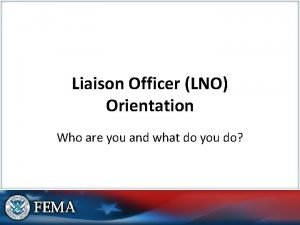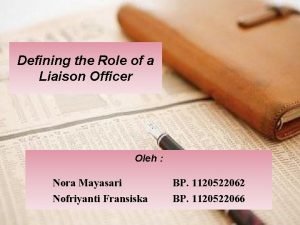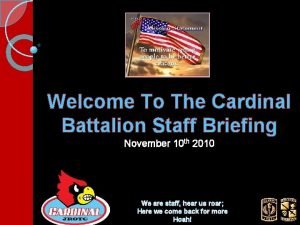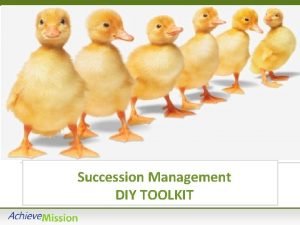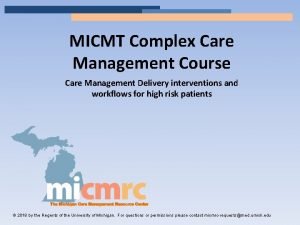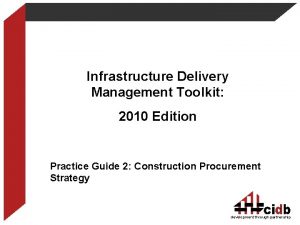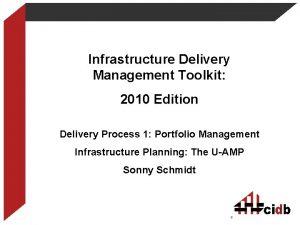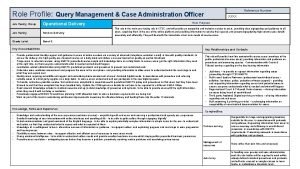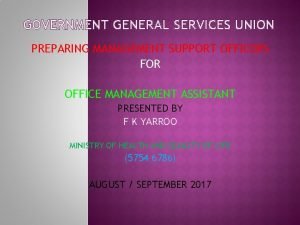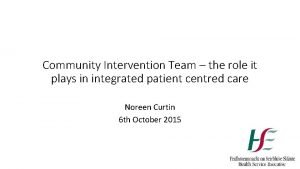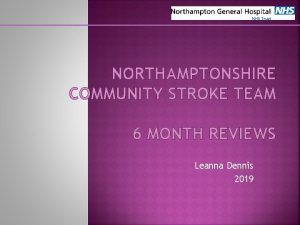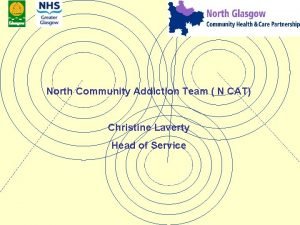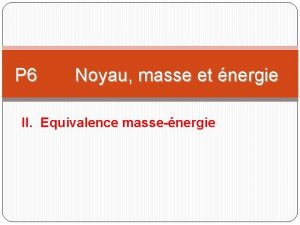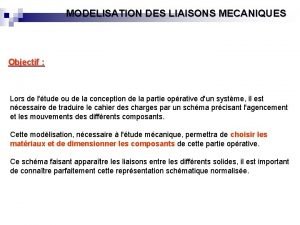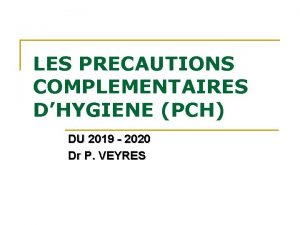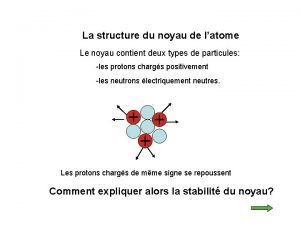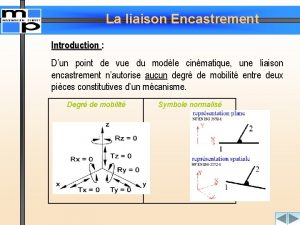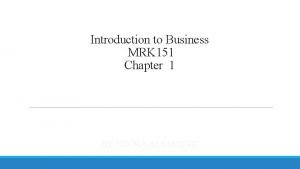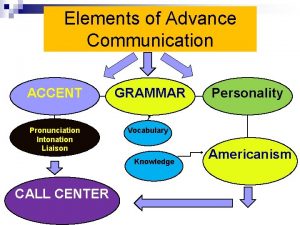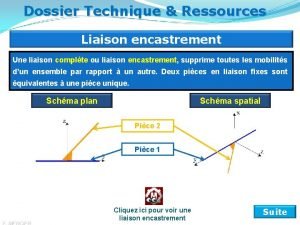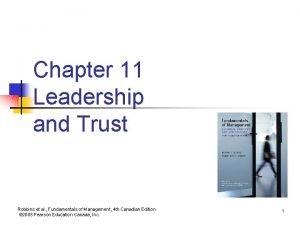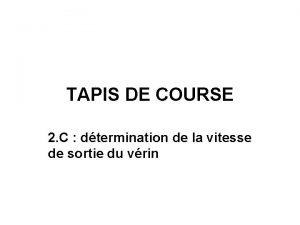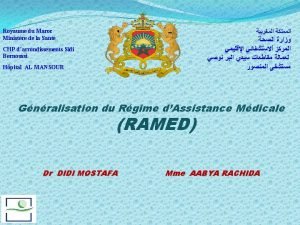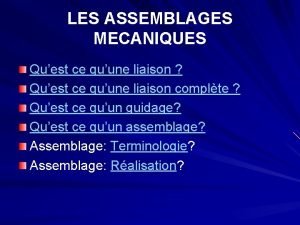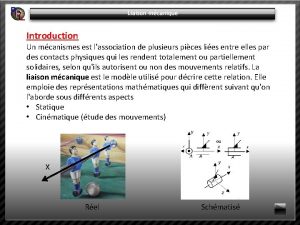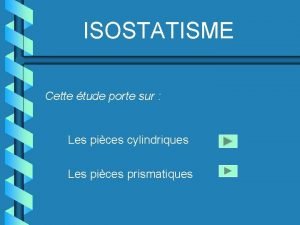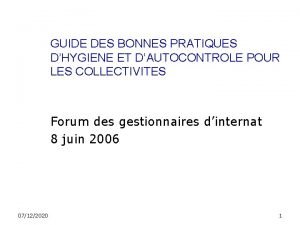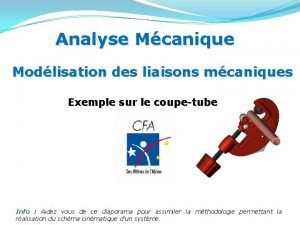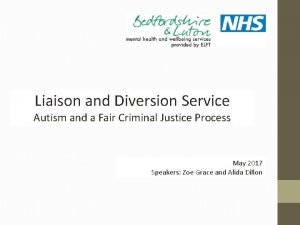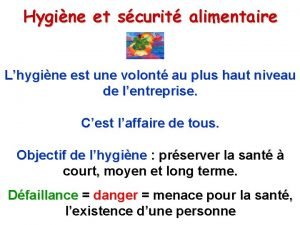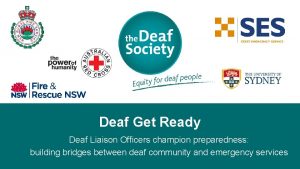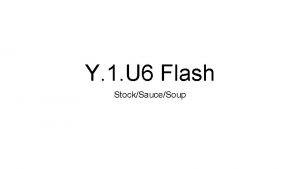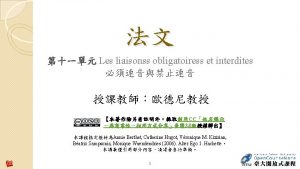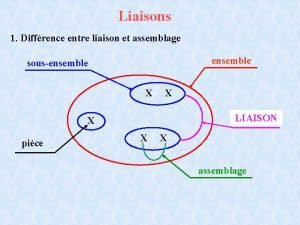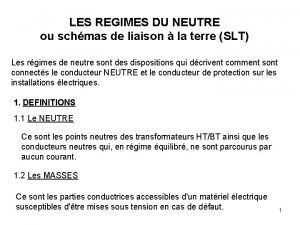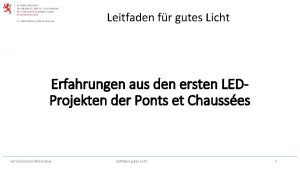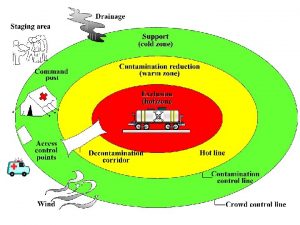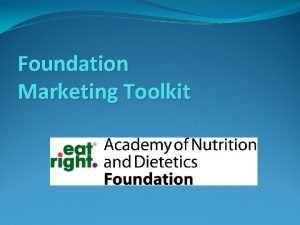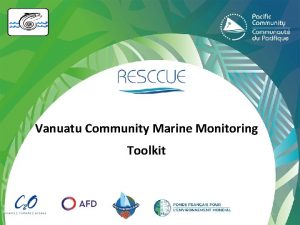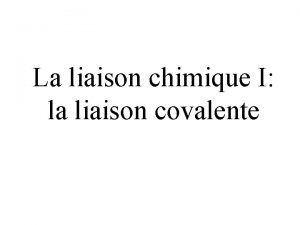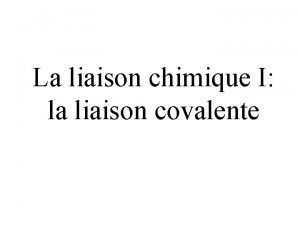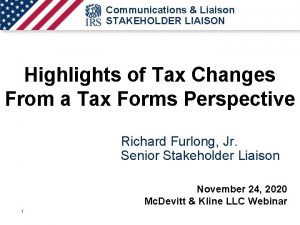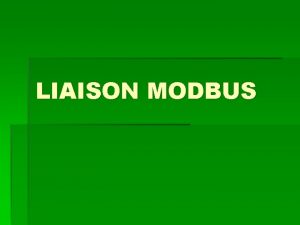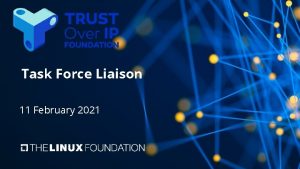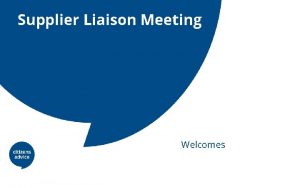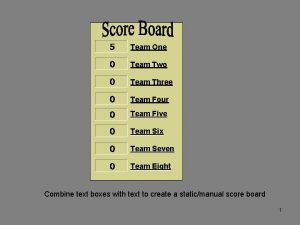Community liaison officer team management toolkit Tool 6




















































![Trust and transparency One does not automatically lead to the other “Complete openness [is] Trust and transparency One does not automatically lead to the other “Complete openness [is]](https://slidetodoc.com/presentation_image_h/ed86cd8d33c26c4b175b34d0a1a55ba5/image-53.jpg)











- Slides: 64

Community liaison officer team management toolkit Tool 6 CLO training pack Part (b): Training slides

Community Liaison Training Course 1. 5 day timetable DAY ONE MODULE 09. 00 Introduction to community liaison • Introduction • Icebreaker • Module 1 11. 30 Stakeholder engagement and consultation • Module 2 14. 00 Tools for engagement • Module 3 15. 30 Managing difficult conversations • Module four introduction • Day one recap DAY TWO MODULE 08. 30 Managing difficult conversations • Introduction to day two and recap • Module 4 exercise 10. 00 Meaningful reporting • Module 5 11. 30 Standards and scrutiny • Module 6 • Course recap 2

Module 1 Introduction to community liaison

Module objectives In this module you will learn: That community liaison is a professional role, requiring high standards of personal integrity and the ability to deal with challenging situations. The ways in which the role is influenced by: The project or asset you work for Your company The community Your own qualities and skills. The importance of mutual respect and teamwork, including the need for open and timely communication with colleagues and community members. 4

Understanding community liaison How would you describe your role? A window? Allowing companies to see out into the community, and the community to see in? 5 A bridge? Facilitating two-way exchanges between companies and communities?

The role is influenced by four principal drivers These drivers are: The project or asset • Stage in life cycle • Contractor track record • Likely employment/de-manning • Impact on land, wider environment and social fabric • Financing Your company • Corporate strategy, culture, leadership and priorities • Policies, brand/reputation, trackrecord • Shareholder interests 6 Society • Local customs, norms and practices • Legislative/regulatory environment • National and local politics • International economic and political trends You • Skills and experience • Specialized knowledge and qualifications • Personal qualities • Relationships, internal and external

Societal influences A dynamic and complex environment You are the interface between company and community; your role is determined by both societal and corporate context. Understanding and valuing both is vital to building understanding between company and community. Communities are shaped by diverse – sometimes competing – historical, cultural and socio-economic factors. A project can bring concerns and changes that people experience in different ways. International influences play into all of this. 7

International influences shape standards Which increasingly address needs of local stakeholders There is a lot of guidance, e. g. : However … • Corporate responsibility − OECD Guidelines • International finance − World Bank/IFC guidance • Certification − − − − 8 ISO 14001 Global Reporting Initiative Indigenous rights ILO 169, 1989; UNDRIP Human rights VPSHR UN Guiding Principles “ 40 per cent of your community engagement can be shaped by generic guidelines and standards, but 60 per cent of it needs to be tailored to the local context. ” Industry respondent (International Institute for Environment and Development, 2016)

What is ‘the community’? Who or what defines a community? Definitions of ‘the community’ – may be geographical, maybe not – can be as broad as ANY impacted individuals. There may be distinct groups within a ‘community’. There may be competing interests between communities or within communities. ‘Communities’ are often defined by their leaders – but how much do they represent the interests of all? ‘Outsiders’ may have an influence on and interest in the community. 9

EXERCISE: PART ONE In groups, draw a ‘map’ or diagram of the community/communities for which you are responsible. Think about: • How people identify themselves: professions, age, gender, language, geography, culture. • The relationships between groups. • Sources of leadership. • International stakeholders. Include vulnerable groups and people inside the company that may interact with the community. 10

Your contribution to the role Skills are important, and so are personal qualities Knowledge of the local culture 72% Honesty 70% Negotiation skills 70% 58% Verbal communication skills 52% Patience 49% Analytical skills Empathy 45% Knowledge of relevant legislation and regulations 43% Knowledge of the company's systems and processes 42% 36% Knowledge of the industry 33% Local language skills Written communication skills 18% A sense of humour 17% 11% English language skills 5% Other 0% 11 Top skills identified in a global online survey of CLOs as key to the role: 78% Respect of the community 20% 40% 60% Percentage of respondents 80% Respect of the community Honesty Negotiation skills Knowledge of local culture Verbal communication skills A global survey of 122 CLOs, undertaken for IPIECA by Audire Consultants and ECW Energy

Your relationship with the community Do you consider yourself a member of the community beyond your role as a CLO? Yes. I’m a resident I’m a bridge between the company and the community People view us as outsiders No! But I have a feeling for them 12 Every day, you create links for co-existence I feel part of my company I am an interlocutor Somehow yes … poverty and inequality are seen by all No. As native communities they are conservative and closed Representative sample of responses from online survey of 122 CLOs undertaken for IPIECA in 2017

EXERCISE: PART TWO Using the maps or diagrams developed earlier, place yourself on the map/diagram in relation to the community using the stickers/magnets provided. Are you an insider/outsider/empathizer. Bridge? Window? Are you comfortable in that place – or would you rather be somewhere else? Look at the maps/diagrams of other groups and discuss what you discovered during the exercise. 13

Module 2 Stakeholder engagement and consultation

Module objectives In this module you will learn: Stakeholder engagement and consultation is the key responsibility of community liaison teams. Sharing insights and using tools such as stakeholder ‘mapping’ helps you to understand a community’s needs, concerns and interests. There is a difference between information sharing, engagement and consultation. Consultation offers the community a real stake in outcomes, but can only happen if they have the right information at the right time. Community leaders (informal and formal) have an important role to play, but those who are not in powerful positions are also important. 15

Why is engagement and consultation important? Mutual understanding helps companies AND communities Understanding perspectives of stakeholders allows needs/concerns to be addressed early and positively. Negative impacts can be more easily minimized and opportunities maximized. Future approaches can be designed to suit stakeholder preferences. Stakeholder engagement and consultation is the only way to forge lasting relationships built on trust and respect. It offers an opportunity to understand manage a range of project risks. 16

What is a ‘stakeholder’? And who are you likely to be interacting with most? A stakeholder is: Any person, group or organization directly or indirectly affected by a project/company. Any person, group or organization who can affect a project/organization. Anyone who has an interest in the project and who can interest it positively/negatively. What about future generations? The environment? 17 Which stakeholders do CLOs most often interact with?

Types of stakeholder interactions ALWAYS carried out in good faith Information sharing: one-way; presentations; leaflets; radio programmes; online disclosure; essential prior to engagement and consultation. Engagement: two-way; formal/informal; meeting people; talking and listening; building relationships/trust. Consultation: two-way; formal; sharing views on specific issues; opportunities for stakeholders to express views on specific issues and decisions and influence outcomes; responsive; challenging. Negotiation: two-way; formal; conducted with representatives selected and approved by stakeholders; concludes in agreement(s); often has legal weight; may involve mitigation commitments, compensation and/or benefitsharing agreements. Inclusive and transparent processes are as important as outcomes 18

What does good engagement look like? There is plenty of advice and good practice guidance According to the IFC, good stakeholder engagement: Begins early Does not wait until there is a problem Takes the long-term view Is tailored to fit your project. It is also important that: It is tailored to fit the company and the communities themselves. 19

Free, prior and informed consent An overarching approach to standards, processes and challenges • Which standards require FPIC? ILO 169; UNDRIP; international financial institutions such as IFC; some national legislation. • What is FPIC? Good faith negotiation; consent freely given (or withheld) prior to development; full information shared about scope and impacts; decision to give or withhold consent is respected and upheld. Goes beyond ‘good engagement’ – ALL rights are recognized and substantively addressed. • What does FPIC look like in practice? Processes and participants are mutually agreed in advance; should be compatible with community decision -making and cultural traditions; formal agreement signed and revisited/maintained over time • Key challenges: Government vs company responsibilities. Who gives consent and how representative are they? Does consent mean veto? How is decision (including a ‘no’) respected over time? How do you know you have consent? 20

Challenges of engagement and consultation Sounds simple, but … Who decides who is a stakeholder? What about ‘stakeholders’ who selfidentify? Are some stakeholders more important than others? If so, how do you decide? How do you, your managers and your colleagues understand prioritize stakeholders? Would stakeholders agree with your priorities? Good community engagement and consultation may not be noticed. It takes time to build trust – and even longer to rebuild broken trust. 21

Leaders, representatives, elected officials Who talks on behalf of others? Leadership may be informal or formal. It is specific to the community and may change over time – sometimes quickly. Examples are elected officials, religious leaders, customary leaders, people nominated by the community. Be aware and manage your relationships with due regard to ethical considerations, company policies and legal requirements. 22

Vulnerable and marginalized groups How do you ensure that you are considering all stakeholders? How do you ensure that you are addressing and responding to the needs of all stakeholders - not only the powerful? These stakeholders may be illiterate or have a physical disability. Meeting formats may be inaccessible and/or inappropriate. Their needs should be considered early and introducing different formats of engagement and consultation feedback appropriate to their needs is important. Solutions can be developed with these stakeholders. 23

An example of vulnerable stakeholders Women are just one potentially vulnerable group • Women may experience specific impacts from a project. • May be excluded from benefits and/or disproportionately experience negative impacts. • Some may be more vulnerable, e. g. single heads of households or women with disabilities. • Important to provide opportunity to engage women separately. • Times and location of meetings may need to be flexible to take into account work and home commitments. • The format and language of meetings is also important to ensure that engagement is appropriate and inclusive. • Approaches could be developed with women’s leaders and women themselves.

Making sense of this complexity Many tools are available to help navigate and prioritize Companies have to make decisions about which stakeholders to engage, how and when. Stakeholder analysis helps to prioritize stakeholders and understand relationships between them. Analysing stakeholders helps make decisions about what interactions are most appropriate – and to create shared understanding across teams. There a number of different mapping tools to support analysis. 25

EXERCISE: PART ONE In small groups, think about your community/communities and rank stakeholders in terms of relevance to the project. Think about: • Why they are important • What their key issues of concern are • Which stakeholders do they influence • Which stakeholders influence them. Discuss the findings. 26

EXERCISE: PART TWO Using the list identified in Part One and the template provided, plot the stakeholders according to the power they have and their influence on, or interest in, the project. In your groups discuss: Which are the most important stakeholders? With which stakeholders should you engage most frequently? Which stakeholders could help you influence others? Are power and influence/interest the only things that matter? 27

Module 3 Tools for engagement

Module objectives In this module you will learn: Communities themselves have a role to play in determining how you communicate with them – and how they communicate with you. Planning is key. Identifying the objective and understanding the stakeholders’ needs are the two critical first steps. The message and the medium are secondary. Nothing replaces meaningful, appropriate and respectful face-to -face communication. 29

Examples of engagement tools Options are varied, and have strengths and weaknesses Face-to-face meetings Tailored information-sharing tools: leaflets, newsletters, posters, advertisements Online platforms: social media, radio broadcasts, TV programmes, websites Formal documents: ESIAs, baseline studies, legal agreements Grievance mechanisms Social investment programmes, participative community development plans, philanthropic projects, sponsorship Stakeholder monitoring and reporting projects 30

The importance of planning Six key steps for creating effective engagement tools Decide your objective: Provide information? Fulfil a regulatory requirement? To agree a complex issue? Identify your audience: Who are you trying to reach? What are their needs? What are the best ways of reaching them? Evaluate third-party tools: Which are trusted? How do they complement your activities? Identify specialist resources and skills: Lawyers, accountants, designers, IT specialists, illustrators, photographers, etc. Develop key messages and effective ways of story-telling: What do your audiences already know. What will their reaction be? Decide the most appropriate tool(s) for your purpose: Think about timelines and the sequence of activities. 31

Face-to-face meetings: the key tool It is not just about substance – style matters too Meeting format and ‘choreography’ make an important contribution to its success. You bring local understanding to bear on meeting design, organization, location, participation, structure and timing. Meetings take many forms: Informal/formal Group/individual Planned/spontaneous Company/community led. 32

EXERCISE: PART ONE In small groups, choose one of the scenarios. Plan a face-to-face meeting as part of your strategy to manage the issues suggested by the scenario. • What sort of preparatory work might be necessary? • Who should attend? Who might attend? • Where would you hold it? • What would the room layout be? • Who would attend from the company? • How would you record it? Sketch our the room layout and explore different kinds of layouts to see how these might affect the dynamic of the meeting. 33

Engagement tools for community participation Opportunity to offer tangible involvement Social investment programmes Can build relationships, share benefits, enhance capacity, demonstrate good intent. Can also be a source of tension, confusion and lead to ethical issues. 34 Community monitoring and scrutiny programmes Can demonstrate trust, enhance capacity, improve corporate performance. Can be challenging for companies and staff and require significant resources.

The principles of good social investment There is plenty of advice and best practice guidance Components of a good programme: A three–five year plan Clear objectives linked to the business case An iterative process involving communities Integrated with a comprehensive stakeholder engagement programme Clear exit and handover strategies Transparent communication of results. 35

Engaging stakeholders who don’t read Same principles apply as with other stakeholders • Important that illiterate stakeholders are able to influence materials and approaches. • Examples for information-sharing and engagement include: − Drama skits − Radio − Cartoons, film and photography. • Collecting and recording feedback: − Voice recording − Mobile phone-based apps – photos, GPS, voice apps − Filmed participatory theatre and film. 36

Engaging with women to unblock an impasse An example of bringing it all together The challenge A project faced delays as a result of problems with communities. Maledominated culture. Women subservient in households, but recognized as a ‘hidden power’ who had an important role to play in long-term development The solution • A stakeholder mapping exercise identified all women in the community, and noted those that appeared influential. • Women engaged via different tools, projects AND different parts of company. Women were engaged in groups, not individuals. • Focus was on families, not ‘women’. The outcome All community members shared a common view on future development, supported by the company. Transformed relationship with whole community. 37

EXERCISE: PART TWO In small groups, return to your scenario and consider: • What tools would support engagement on the issues that it suggests? • Do any of the stakeholders involved have specific communication needs? • Sketch a timeline for the meeting itself and the related communication tools. • What – if any – follow-up do you envisage? • What would success look like? For you? For the community? 38

Module 4 Managing difficult conversations

Module objectives In this module you will learn: Planning how to deal with difficult conversations/grievances, seeking help and specialist advice, having appropriate, workable processes, keeping good records and asking for, and offering, support from colleagues can help manage one of the most challenging aspects of the job. A difficult conversation or grievance managed well can be a rewarding experience for the stakeholder – and you. Difficult conversations and grievances are not signs of weakness – they may equally be signs of open and honest relationships. Tracking grievances/complaints can help to identify emerging problems. 40

Difficult conversations and complaints These are an inevitable part of any project Common causes of complaints/grievances: Dust, noise and damage to property (Lack of) access to opportunities Land compensation issues Labour force behaviour Ethical concerns. Ways in which they escalate: Failure of the company to respond (in time) Failure to keep promises Manipulation by others Track record of rewarding disruptive behaviour Behaviour of staff handling grievance. 41 RESPECT RECORD RESPOND

Managing difficult conversations Three building blocks for CLOs Before the meeting Consider issue from the other side During the meeting Be aware of circumstances changing since you agreed to meet Mutually agree objective and extent of your role Adopt a mindset of inquiry and be consistent Choose the right venue, format and time Anticipate/manage emotions – don’t fear Agree process and roles silence of home team Preserve the relationship Consider warm up meetings Know how to begin/end 42 After the meeting Make a record while still fresh and share with attendees if appropriate Note promises and commitments, including response times Note actions, share lessons, help others Respond as promised – or be transparent if you can’t

EXERCISE In small groups, choose one of the role-playing scenarios. Decide who will play each role, and who will act as an observer. Remember the lessons from previous modules and take time to prepare and plan. Role play the conversation for as along as it takes to reach a conclusion that the observer is happy with. The role-playing can be done in front of all participants or just as groups. 43

Components of an effective grievance mechanism An invaluable tool for managing complaints An effective grievance mechanism is: Clear, transparent, predictable, consistent, accessible and userfriendly Made public Has a clear time frame of response Respects the person making the complaint and ensures their safety Has further avenues for recourse and does not exclude alternative options, including legal ones. 44

How do you know its working? An effective grievance mechanism offers many benefits Signs that the mechanism is working: There are grievances! No grievances is not a an indication of success. Range of stakeholders aware of mechanism – and agree it meets needs. All members of the community use it, including vulnerable groups. At the start, there is an increase in grievances, followed by a decrease. Fewer grievances need to be escalated. You use the data to reveal emerging problems. 45

What is the role of the CLO in the mechanism? You are vital A Community Liaison Officer: Ensures that stakeholders are aware of the GM, the processes involved and how grievances are resolved. Receives, acknowledges and registers grievances using the system. Supports complainants in using the mechanism. May investigate grievances and provide information for assessment. Plays a role in resolving grievances informally and via the mechanism. May find the role uncomfortable, challenging – but rewarding. 46

Module 5 Meaningful reporting

Module objectives In this module you will learn: Documenting meetings accurately, recording decisions and agreeing outcomes with community members is vital to effective management of community issues. Data protection legislation and human rights requirements affect the way in which personal information is stored and shared. Companies and projects have requirements for information to be shared internally to fulfil legal requirements, meet public commitments, manage broad trends and identify emerging issues and risks. There are opportunities and risks associated with sharing information transparently with stakeholders. 48

Why meaningful documentation matters (I) Well-designed reporting processes help community engagement Accurate records of meetings, conversations and decisions remove ambiguity and avoid future disputes. Community members should agree on how information is captured and disseminated, and the content of minutes of meetings in which they are involved. Care should be taken to ensure the tools used to capture this information meets the needs of all those impacted – including illiterate stakeholders. The Grievance Mechanism is one – but not the only – example. 49

Why meaningful documentation matters (II) Well-designed reporting processes help companies and projects • Companies and projects are underpinned by information systems and processes – insights and input from CLOs are important. • This helps them to manage performance, risks and change efficiently – and legally. This helps CLOs too. • It is important to understand the needs of internal decision-makers. • Templates and processes help community-facing teams use the same language and present information in a way that is most useful to colleagues. • There are plenty of templates available online for minute-taking. 50

Collecting, storing and sharing information There will be cultural, legal and human rights considerations Communities will have views about how information is collected, stored and shared. This may include limitations on taking photographs at meetings, recording the names of attendees or speakers, and restricting the sharing of information with officials. There may be legal requirements requiring information to be shared – for example if there is criminal activity. Legal and human rights considerations govern information collection, storage and sharing. 51

Reporting community performance How to report to the community about the community Focused on Sustainability Reporting – but other tools are available. Guiding principle of sustainability reports is that they should respond to stakeholder needs. They can be useful tools for information sharing and engagement activities … but how far do they do that? Other tools may offer more immediate feedback on community-related issues 52
![Trust and transparency One does not automatically lead to the other Complete openness is Trust and transparency One does not automatically lead to the other “Complete openness [is]](https://slidetodoc.com/presentation_image_h/ed86cd8d33c26c4b175b34d0a1a55ba5/image-53.jpg)
Trust and transparency One does not automatically lead to the other “Complete openness [is] not the best ways to build or restore trust. We place and refuse trust not because we have torrents of information (more is not always better), but because we can trace specific bits of information and specific undertakings to particular sources on whose veracity and reliability we can run some checks. ” Baroness Onora O’Neill, BBC Reith Lectures, 2002 In Modules 1, 2, 3 and 4 you have explored the purpose and characteristics of relationships build on mutual respect and trust. Open and honest communication about community impacts and issues is important. But ‘more’ does not always mean ‘better’. 53

EXERCISE In small groups identify: What information they need to do their jobs effectively. What information do CLOs need to give other people to allow them to do their jobs effectively? How should this information be collected? And how should it be stored and made available? What are the barriers to the above? Review/design a reporting framework for your team. Finally, discuss what information about the community should be shared with the community. 54

Module 6 Standards and scrutiny

Module objectives In this module you will learn: A CLO’s role will be governed by national, and possibly international, laws and regulation. Companies and projects also have their own policies and standards. International organizations have also created a raft of standards, guidance and good practice. Knowing where to find information in these documents can help navigate unfamiliar, complex and difficult situations and issues. Activities which impact communities are subject to scrutiny – both formal and informal. 56

Global standards support community liaison And may be required by companies, governments and/or lenders Knowledge is of two kinds. We know a subject or we know where we can find useful information upon it Samuel Johnson, 1775, carved on wall of the British Library 57

Questions determining which standards apply Even if not explicitly required, standards can be helpful National and international standards Who are the lenders? What international conventions and initiatives has the country signed up to? What national and regional legislation applies? Project and company standards What companies are involved – and what legislation governs them? What standards are referenced in legal and contractual agreements? What voluntary commitments has the project or company made? What commitments have been made publicly? 58

Standards are translated into project documents Plans, agreements and programmes adapt and incorporate Tools are where standards meet project and asset reality: Environmental and social impact assessments Human rights impact assessment Stakeholder engagement plan Grievance mechanism Resettlement action plan Benefit-sharing agreements Community development plan 59

How is compliance monitored? How to enforce standards and acknowledge local circumstance Host governments, lenders, parent companies, other investors, communities, NGOs, and independent expert panels may all have monitoring rights and interests. Building trust between local team (including CLOs) and auditors and scrutineers is invaluable for both ‘sides’. Auditors and scrutineers and local team should take time to understand each others’ concerns. Auditors and scrutineers may have a mentoring role and can be advocates for community-facing team. Communities may be involved in scrutiny bodies or may provide feedback to them. 60

Who scrutinizes performance? Baku-Tbilisi-Ceyhan pipeline: an example of scrutiny in practice Lenders: IFC and EBRD Lenders: Commercial banks Host governments x 3 Project: BP operated Lenders: Credit agencies Expert Advisory Panel (CDAP) Local NGO monitoring project (OS) Each had their own methodology stakeholders, remit, timetable and response requirements 61 Partners: 11 companies

EXERCISE In each small groups consider how you would scrutinize the projects if you were ONE of the following: • A government inspector • An international financial lender • A human rights auditor • An international environmental NGO • A community. What would you scrutinize? What standards would you use? What ‘proof’ would you look for? What are the most difficult questions you could ask? Would you cover everything in person – or use others? Would you visit? What desk research would you do? 62

Wrap-up and summary

Summary of training Your role is vital “ 40 per cent of your community engagement can be shaped by generic guidelines, standards and toolkits but 60 per cent needs to be tailored to the context. ” Industry respondent (International Institute for Environment and Development, 2016) 64
 The liaison officer fema
The liaison officer fema Liaison role adalah
Liaison role adalah Accreditation liaison officer
Accreditation liaison officer Drill team officer binder
Drill team officer binder Community helpers police officer
Community helpers police officer Going native project management
Going native project management Team spirit becomes team infatuation
Team spirit becomes team infatuation The white team cheers for the blue team, just like
The white team cheers for the blue team, just like Talent review chart
Talent review chart Complex care management toolkit
Complex care management toolkit Infrastructure delivery management
Infrastructure delivery management Infrastructure delivery management toolkit
Infrastructure delivery management toolkit Infrastructure delivery management toolkit
Infrastructure delivery management toolkit Enemy corner seating arrangement
Enemy corner seating arrangement Query management and case administration officer
Query management and case administration officer Management support officer psc
Management support officer psc Potter's tool is data cleaning tool
Potter's tool is data cleaning tool Community intervention team
Community intervention team Community stroke team northampton
Community stroke team northampton Christine laverty
Christine laverty Kyria liaison
Kyria liaison Cecilia gunnarsson
Cecilia gunnarsson Liaison phosphoanhydride
Liaison phosphoanhydride énergie de liaison d'un noyau
énergie de liaison d'un noyau Liaison mecanique
Liaison mecanique Medical liaison job description
Medical liaison job description Liaison instrument
Liaison instrument Fiche de liaison transfert patient
Fiche de liaison transfert patient Liaison complete et partielle
Liaison complete et partielle Numero atomique
Numero atomique Liaison encastrement
Liaison encastrement Manager or supervisor higher
Manager or supervisor higher Boue dentinaire
Boue dentinaire Organe de liaison exemple
Organe de liaison exemple Betty botter
Betty botter Assemblage démontable schéma
Assemblage démontable schéma Liaison pivot parfaite
Liaison pivot parfaite Liaison permanente
Liaison permanente Liaison with external constituencies
Liaison with external constituencies Liaison hydrogéne
Liaison hydrogéne Dimensionnement palier lisse
Dimensionnement palier lisse Liaison ponctuelle
Liaison ponctuelle Liaison pivot
Liaison pivot Fiche de liaison ramed
Fiche de liaison ramed Symbole liaison pivot
Symbole liaison pivot Liaison par pincement
Liaison par pincement Liaison rotule à doigt
Liaison rotule à doigt Tp fiche de liaison
Tp fiche de liaison Adverbes de relation logique
Adverbes de relation logique Expert in consultant liaison psychiatrist
Expert in consultant liaison psychiatrist Centrage long centrage court
Centrage long centrage court Liaison linéaire annulaire
Liaison linéaire annulaire Schéma liaison froide
Schéma liaison froide Le coupe tube schéma cinématique
Le coupe tube schéma cinématique Liaison and diversion interview questions
Liaison and diversion interview questions La liaison obligatoire
La liaison obligatoire Liaison interdites
Liaison interdites Diagramme le principe de la liaison froide réfrigérée
Diagramme le principe de la liaison froide réfrigérée Building liaison
Building liaison The process of eliminating bones or impurities
The process of eliminating bones or impurities Liaison pivot coussinet
Liaison pivot coussinet Liaisons interdites
Liaisons interdites Liaison
Liaison Régime de neutre tns et tnc
Régime de neutre tns et tnc Liaison micheville
Liaison micheville
